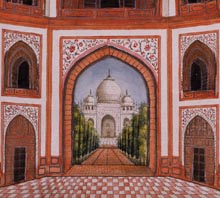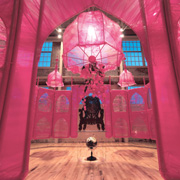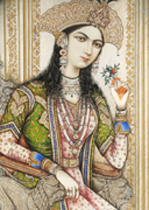Contribute
| Taj Mahal - The Building Of A Legend |
Press Release
09/28/2005
The Taj Mahal: The very name evokes grandeur, beauty, and mystery. Only
a handful of structures—the Egyptian Pyramids, the Leaning Tower of
Pisa, and the Great Wall of China—are as universally recognized. This
fall, the Peabody Essex Museum opens Taj Mahal, the Building of a
Legend, an exhibition of approximately 40 paintings, watercolors,
photographs, and objects that explore the architecture and mystique of
this remarkable site. Drawn mainly from the museum’s Asian Export Art
collection and organized by curator Karina Corrigan, Taj Mahal runs
from Oct.15, 2005, through July 23, 2006.
Renowned for its
architectural magnificence and for the dramatic love story that
inspired its construction, the Taj Mahal was built by the Indian
Emperor Shah Jahan as a tomb for his beloved wife, Mumtaz Mahal.
Highlights of the exhibition include an important pair of portraits on
ivory of the royal couple—new acquisitions to the museum’s permanent
collection. With their bold outlines and brilliant colors, the
portraits demonstrate how Indian artists adapted Mughal miniature
techniques for European patrons.
In the late 18th–century,
as the power of the Mughal court waned, a genre of paintings known as
“Company paintings†emerged. The term got its name from the British
East India Company, which hired Indian artists to create images for a
new European clientele. Company paintings of Mughal monuments are
fascinating both as architectural studies of important buildings and as
documents of the interaction between Indian and British cultures in the
early 19th century. Over twenty paintings of the Taj Mahal and Agra
from this era are on display, including seven important works by Sita
Ram. Painted in 1815, the works are a perfect example of the European
style and technique of capturing light and shade, space and volume that
were favored in the day.
Visitors will also be able to see a
late 19th–century chessboard made by the artistic descendants of the
Taj’s original builders. Fashioned of marble and semi- precious stones,
the piece illustrates the Taj Mahal inlay technique to sumptuous
effect. PEM’s alabaster and agate model of the Taj Mahal, one of the
largest and most exquisite mementos brought back by a Western visitor
to Agra, is also included in the exhibition. It is a work of luminous
detail and an enduring tribute to the original form. Nineteenth–
century photographs by English artist Samuel Bourne and more recent
photographs by Kenro Izu of sites in Agra complement these paintings
and objects.
A Contemporary Artist’s Response
As a contemporary counterpoint to the historical works in the
exhibition, artist Rina Banerjee’s plastic– wrapped re-creation of the
Taj Mahal will be installed in the museum’s Atrium. Take me, Take me,
Take me . . . to the Palace of Love is a 19-foot high copper frame,
wrapped in several thousand square feet of hot pink Saran Wrap.
Suspended from the Atrium’s soaring 60-foot ceiling, the installation
hangs like “a gigantic yet delicate ornament, a fanciful flying
machine, or even a latter-day architectural folly,†writes curator
Karina Corrigan in the catalogue that accompanies the exhibition.
Inside this rosy “palace†are a plastic chandelier and a heavily carved
19th–century Anglo-Indian chair over a semiprecious stone globe.
Banerjee selected the chair from the Peabody Essex Museum’s notable
collection of furniture from British India. The installation evokes a
view of India through rose- tinted glasses—a romanticized view that
characterized the colonial British presence in India.
Banerjee is a Kolkata-born, Brooklyn-based artist with previous
installations in Spain, Africa, India, Canada, and the United States.
Building a Legend
Company paintings were among the earliest images to communicate the
grandeur of the Taj Mahal, but it was photography that helped fuel the
building’s status as a legend. An entire industry of mass– produced
images of the Taj, was born. Advertising and marketing campaigns have
used the Taj Mahal to sell everything from T-shirts, hotels, and
airlines to basmati rice, beer, and broadband service. Every day,
thousands of visitors have their photos taken in front of the famous
structure. Visitors to the Peabody Essex Museum can participate
vicariously in this ritual by having their photos taken in front of a
mural of the building as part of the exhibition. A monitor in the
gallery features these portraits along with a technology-based
scrapbook of famous and anonymous visitors to the Taj Mahal.
About the Taj Mahal
The Taj Mahal was built along the banks of the Yamuna River, near the
city of Agra, the imperial seat of Mughal rulers during the 16th and
early 17th centuries. The fifth Mughal Emperor Shah Jahan (1592-1666)
commissioned the structure as a tomb for himself and his wife, Arjumand
Banu, better known as Mumtaz Mahal (Exalted One of the Palace). Mumtaz
Mahal was her husband’s inseparable companion and counselor until her
death in 1631. The tomb is a 42-acre site of courtyards, gardens, and
structures laid out as a cosmic diagram of paradise on earth. After 23
laborious years, and the combined efforts of over twenty thousand
workers and master craftsmen, the complex was finally completed in
1654. The government of India recently celebrated a year-long festival
to commemorate the 350th anniversary of its completion.
Shah
Jahan, whose name means “Ruler of the World,†was the fifth of the
legendary Mughal emperors of India. He was a great military leader, but
was also a celebrated patron and connoisseur of miniature paintings,
jewels, textiles, jade, and architecture. His throne was one of the
most lavish pieces of furniture ever constructed. Shah Jahan sat on
this “peacock†throne, encrusted with gold, diamonds, rubies, and
sapphires, for daily audiences with his subjects at the Agra Fort.
Tragically those sumptuous surroundings would ultimately become his
prison. His son, Aurangzeb, seized the throne and imprisoned his father
for the last eight years of his life. Legend maintains that Shah Jahan
spent his final years locked in the Agra Fort, gazing from the Jasmine
Tower of his marble palace, down the Yamuna River to the Taj Mahal, the
tomb of his beloved wife.
Asian Export Art Collection
The department of Asian export art at the Peabody Essex Museum is
internationally recognized as housing the largest, most comprehensive
collection of its type in the world, consisting of over 25,000 objects
made in China, Japan and India for the Western market between the 15th–
and 21st– centuries. Works in the collection range from porcelain, to
lacquer, paintings, silver, textiles, and ivory, among others. While
the museum was founded by Americans who made their fortunes in the
China trade, the majority of the collection was produced for the
European market and dates to the 18th– century, the apex of
international commerce between Asia and the West.
The Peabody Essex Museum
The recently transformed Peabody Essex Museum presents art and culture
from New England and around the world. The museum's collections are
among the finest of their kind, showcasing an unrivaled spectrum of
American art and architecture and outstanding Asian, Asian Export,
Native American, African, Oceanic, Maritime, and Photography
collections. In addition to its vast collections, the museum offers
changing exhibitions and a hands-on education center. The museum campus
features numerous parks, period gardens, and 24 historic properties,
including Yin Yu Tang, the only example of Chinese vernacular
architecture on display in the United States. The Peabody Essex Museum
is open daily, 10 a.m. to 5 p.m. The museum is closed Thanksgiving,
Christmas, and New Year's Day. General museum admission: Adults $13;
seniors $11; students $9 Additional admission to Yin Yu Tang: $4
Members, youth 16 and under, and residents of Salem enjoy free general
admission and free admission to Yin Yu Tang. Location: East India
Square, Salem, MA 01970. Call 866-745-1876 or visit our Web site at
www.pem.org.
You may also access this article through our web-site http://www.lokvani.com/


